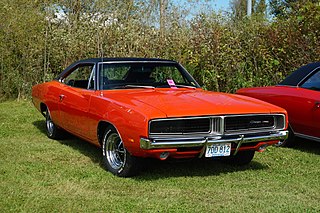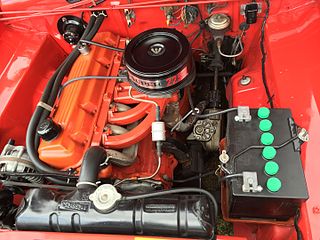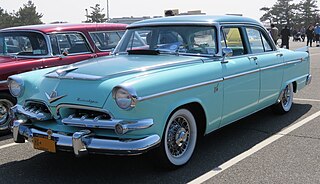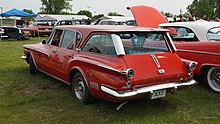
Plymouth was a brand of automobiles produced by Chrysler Corporation and its successor DaimlerChrysler. The brand was launched in 1928 to compete in what was then described as the "low-priced" market segment that was dominated by Chevrolet and Ford. It became a high-volume seller for the automaker until the late 1990s. Plymouth cars were marketed primarily in the United States. The brand was withdrawn from the marketplace in 2001. The Plymouth models that were produced up to then were either discontinued or rebranded as Chrysler or Dodge.

The Chrysler New Yorker is an automobile model produced by Chrysler from 1940 until 1996, serving for several decades as either the brand's flagship model or as a junior sedan to the Chrysler Imperial, the latter during the years in which the Imperial name was used within the Chrysler lineup rather than as a standalone brand.

The Dodge Charger is a model of automobile marketed by Dodge in various forms over eight generations since 1966.

The Plymouth Valiant is an automobile which was marketed by the Plymouth division of the Chrysler Corporation in the United States from the model years of 1960 through 1976. It was created to give the company an entry in the compact car market emerging in the late 1950s. The Valiant was also built and marketed, without the Plymouth brand, worldwide in countries including Argentina, Australia, Brazil, Canada, Finland, Mexico, New Zealand, South Africa, Sweden and Switzerland, as well as other countries in South America and Western Europe. It became well known for its excellent durability and reliability, and was one of Chrysler's best-selling automobiles during the 1960s and 1970s, helping to keep the company solvent during an economic downturn.

The Plymouth Barracuda is a two-door pony car that was manufactured by Chrysler Corporation from 1964 through 1974 model years.

The Dodge Dart is a line of large passenger cars produced by Dodge from the 1959 to 1976 model years in North America, with production extended to later years in various other markets.

The Slant-Six is the popular name for a Chrysler inline-6 internal combustion engine with an overhead valve reverse-flow cylinder head and cylinder bank inclined at a 30-degree angle from vertical. Introduced in 1959 for the 1960 models, it was known within Chrysler as the G-engine. It was a clean-sheet design that began production in 1959 at 170 cubic inches (2.8 L) and ended in 2000 at 225 cubic inches (3.7 L). It was a direct replacement for the flathead Chrysler straight six that the company started business with in 1925 until the old design was discontinued in the 1960s.

The Chrysler LeBaron, also known as the Imperial LeBaron, is a line of automobiles built by Chrysler from 1931 to 1941 and from 1955 to 1995. The model was introduced in 1931, with a body manufactured by LeBaron, and competed with other luxury cars of the era such as Lincoln and Packard. After purchasing LeBaron with its parent Briggs Manufacturing Company, Chrysler introduced the luxury make Imperial in 1955, and sold automobiles under the name Imperial LeBaron until 1975. Chrysler discontinued the Imperial brand in 1975, and reintroduced the Chrysler LeBaron in 1977 to what was then Chrysler's lowest priced model.

The Chrysler Valiant was a full-size car which was sold by Chrysler Australia between 1962 and 1981. Initially a rebadged locally assembled Plymouth Valiant from the United States, from the second generation launched in 1963, the Valiant was fully manufactured in Australia. It was sold locally but also in New Zealand and South Africa, with smaller numbers also exported to South-East Asia and the United Kingdom.

The Dodge Colt is a subcompact car that was manufactured by Mitsubishi Motors and marketed by Dodge for model years 1971 to 1994 as captive imports. Rebadged variants include the Plymouth Champ and Plymouth Colt, both were marketed by Plymouth.

The Dodge Aspen, and the nearly-identical PlymouthVolaré, are compact cars that were produced from 1976 until 1980. The Volaré/Aspen model line offered a four-door sedan, a two-door coupe, and a four-door wagon.

The Dodge Diplomat is an American mid-size car that was produced by Dodge from 1977 to 1989. At launch, it shared a common design with the Chrysler LeBaron and for much of its later production run was the counterpart of the more upscale Chrysler Fifth Avenue and lower priced Plymouth Gran Fury. It was also sold in Mexico between 1981 and 1982 as the Dodge Dart, and in Colombia as the Dodge Coronet. The Diplomat was initially offered in a coupe and a sedan; in 1978, station wagons were added as replacements for the discontinued full-sized C-body wagons.

The Plymouth Fury is a model of automobile that was produced by Plymouth from 1955 until 1989. It was introduced for the 1956 model year as a sub-series of the Plymouth Belvedere, becoming a separate series one level above the contemporary Belvedere for 1959. The Fury was a full-size car from 1959 until 1961, then a mid-size car from 1962 until 1964, again, a full-size car from 1965 through 1974, and again, a mid-size car from 1975 through 1978. From 1975 until 1977, the Fury was sold alongside the full-size Plymouth Gran Fury. In 1978, the B-body Fury was the largest Plymouth, and by 1979, there was no large Plymouth. This product gap was filled in 1980 with the R-body Gran Fury, followed by the M-body Fury in 1982. Production of the last V8, RWD Plymouth Fury ended at the Kenosha Main assembly plant in Kenosha, WI, on December 23, 1988. Unlike its sibling brand, Dodge, Plymouth would not live to see the resurgence of the large, V8/RWD sedan.

The Plymouth Savoy is an automobile model produced from the 1954 through 1964 model years by Plymouth.

The Dodge Polara is an automobile introduced in the United States for the 1960 model year as Dodge's top-of-the-line full-size car. After the introduction of the Dodge Custom 880 in 1962, the Polara nameplate designated a step below the full-sized best-trimmed Dodge model; the Polara that year had been downsized to what was in effect intermediate, or mid-size status. In its various forms, the Polara name was used by Dodge until 1973, when its position in Dodge's line-up was replaced by the Dodge Monaco.

The Newport was a name used by Chrysler for both a hardtop body designation and also for its lowest priced model between 1961 and 1981. Chrysler first used the Newport name on a 1940 show car, of which five vehicles were produced. From 1950 to 1956, the Newport name was then used to designate any Chrysler model with a hardtop body style. In 1961, Chrysler introduced the Newport as a new, low-priced model, offering large, comfortable two- and four-door Chrysler models that were modestly priced compared with the Chrysler 300, the Chrysler New Yorker and the Imperial. For 1961, the Newport was priced below the Chrysler Windsor in the Windsor's final year.

The Dodge Custom 880 is an automobile that was marketed by Dodge from 1962 through the end of the 1965 model year. It was positioned as Dodge's product offer in the mid-price full-size market segment and to help fill the void in Chrysler's lineup left by the discontinuation of DeSoto in 1961.

The 1955 Dodge car lineup, consisting of the entry-level Coronet, Royal, and ornate Custom Royal, was a major departure for the company. Driven almost out of business in 1953 and 1954, the Chrysler Corporation was revived with a $250 million loan from Prudential and new models designed by Virgil Exner. The Dodge lineup was positioned as the mainstream line in Chrysler's hierarchy, between DeSoto and Plymouth.
The Dodge 440 is a mid-size car that was marketed by Dodge from 1962 to 1964.

The Plymouth XNR is a concept car developed by Chrysler. It was designed by Virgil Exner, and first shown in 1960. Also called the XNR 500, the car is an open roadster with some asymmetric features, and was proposed as a sporty addition to the Plymouth model lineup, and as competition for the Chevrolet Corvette.


























